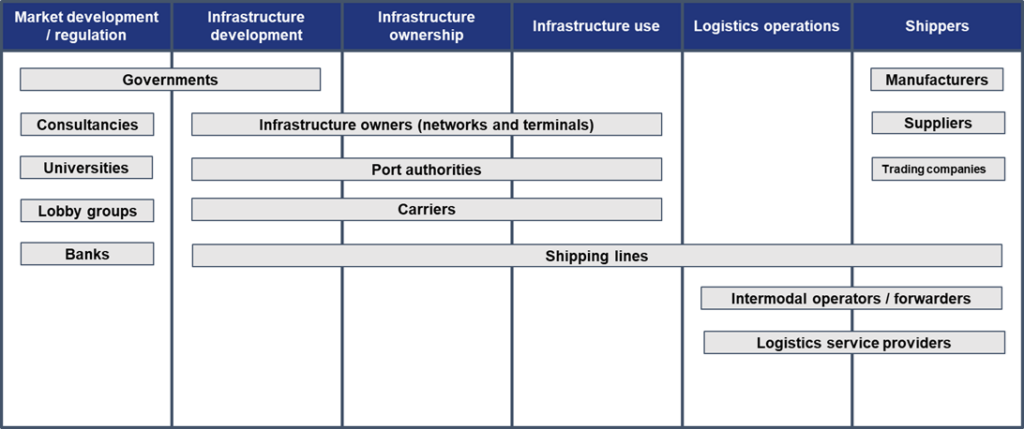This chapter is part of the LOBRA project. It presents a classification of the main stakeholders involved in transport logistics.
Stakeholders in the Transportation Industry
The transportation industry is a system of interconnected actors that enable the movement of goods and people across regions and countries. It supports trade, production, and daily consumption, and is shaped by a range of organizations, institutions and service providers.
To understand how transportation functions in practice, it is useful to identify the main groups of stakeholders and the roles they perform. These stakeholders can be classified based on their position in the system and their influence over transport flows, infrastructure, services and regulations. The stakeholders can be classified into: public authorities & regulators, infrastructure owners & developers, operators, logistics service providers, shippers, financial & knowledge institutions. A general overview picture can be seen in Figure 1.

Figure 1: Stakeholders of the transportation field. (Rodemann, H., de Jong, F., Ruijgrok, K., & Verweij, K. (2018). The vitality of intermodal transport.
1. Public Authorities and Regulators
These actors set the legal and policy framework for transportation. They define safety standards, environmental requirements, competition rules and access rights. Public authorities also fund infrastructure projects and influence the direction of long-term planning.
Examples:
- National ministries of transport
- Municipal governments
- Transport safety agencies
- Customs authorities
- European Commission (in the EU context)
2. Infrastructure Owners and Developers
These stakeholders manage physical transport networks such as roads, railways, ports and airports. They may be public or private and are responsible for the construction, maintenance and availability of infrastructure.
Examples:
- Rail infrastructure managers (Fintraffic)
- Port authorities (Port of Helsinki, Port of HaminaKotka)
- Airport operators (Finavia)
- Private investors and construction firms
3. Transport Operators
These companies use infrastructure to provide transport services. They move goods or passengers using different modes such as road, rail, maritime or air. They may operate domestically or across borders, under licenses and contracts. These companies are the actual operators of the field that provide operational services.
Examples:
- Trucking companies
- Railway operators
- Shipping lines
- Airlines
- Last-mile delivery providers
4. Logistics and Supply Chain Service Providers
These actors manage and coordinate the flow of goods. They offer planning, storage, consolidation and handling services, often combining multiple transport modes. Their goal is to organize cost-efficient and reliable supply chains for their customers. This is the stakeholder group that is in-between the shippers and the transport operators.
Examples:
- Freight forwarders
- Third-party logistics (3PL) companies
- Intermodal terminal operators
- Warehousing providers
5. Shippers and Cargo Owners
Shippers generate demand for transportation. They produce, buy, or sell goods and require logistics services to reach markets or production sites. Their transport needs influence the design and scheduling of logistics chains.
Examples:
- Manufacturing companies
- Retailers and wholesalers
- Importers and exporters
- E-commerce businesses
6. Financial and Knowledge Institutions
This group includes organizations that support the industry with funding, research, technology and advisory services. They influence innovation, strategic decisions and policy development through studies, investments and consultation.
Examples:
- Banks and investment funds
- Universities and research institutes
- Industry associations
- Consulting firms
Each of these stakeholder groups interacts with others in ways that shape the efficiency, resilience and sustainability of the transportation system. Mapping these roles is a starting point for understanding how transport networks operate, how decisions are made and where cooperation or conflict may occur. Each of these stakeholder groups corresponds to real-world actors with defined roles and interests. Their presence and interactions can be observed in the daily functioning and strategic development of transport systems.
If you are interested in the field of logistics and supply chain management and want to stay informed about developments and trends, keep in touch with the project!

Project number: 404191
